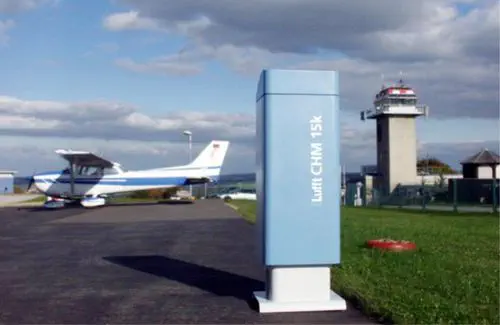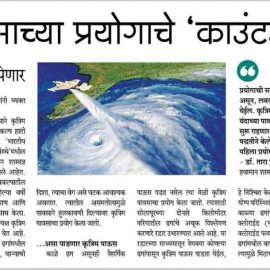The LIDAR-based cloud height sensor / ceilometer CHM 15k is prepared to work throughout the year and in any climate
Exact results due to high sensitivity of the used lidar sensor technology! Reliable and accurate results at any time of the day or night are ensured by long-life laser sources, filters with narrow bandwidth and high-sensitivity photodetectors.
The Indian Institute of Tropical Meteorology (IITM) is a scientific institution based in Pune. It is a premiere research institute to generate scientific knowledge in the field of meteorology and atmospheric sciences that has potential application in various fields such as agriculture, economics, health, water resources, transportation, communications, and more.

So far they acquired two units of Lufft CHM 15k Ceilometers. One is deployed at the Indira Gandhi International Airport, New Delhi and the other at their Observatory in Solapur. The first one was initially used for the cloud interference study due to “smog” that occurred because of stubble burning in the fields of Punjab last year. It has continued but for airport-related cloud profiling. The second CHM is used for the “cloud-seeding” project “CAIPEEX”, which stands for “Cloud Aerosol Interaction and Precipitation Enhancement Experiment”.
Meanwhile, we received their new order for the supply of two more units of CHM 15k ceilometers, which will be used for the “National Monsoon Mission” project.
Über das Indian Institute for Tropical Meteorology

The Indian Institute of Tropical Meteorology (IITM) based in Pune, India, is an autonomous research institute of the Ministry of Earth Sciences (MoES), Govt. of India, which is responsible for obtaining scientific knowledge in the fields of meteorology and atmospheric research. It conducts studies in agriculture, economics, healthcare, hydrology, transportation, communications and more.


One of these was first used in Punjab for a study on the observation of “smog”, which arose during the burning of cereal stubble on the fields. The cloud height sensor is now part of a cloud profiling study at Indira Gandhi International Airport in New Delhi.
The second CHM 15k is installed on an observatory in Solapur for a study called “Cloud Aerosol Interaction and Precipitation Enhancement Experiment” (short “CAIPEEX“). The aim here is to explore so-called “cloud seeding”, which is the artificial generation of precipitation using chemicals that alter the microphysical processes within the cloud. The experiment will be carried out for over three years in the “rain shadow” region of Solapur and is now in its second year. A rain shadow is an area that lies on the lee side of a mountain. That is the side facing away from the wind, where much less precipitation occurs than on the opposite side of the mountain, the windward side.
Sutron India, now HACH DHR India Pvt. Ltd., was entrusted with the delivery, installation and commissioning of the two Ceilometers at New Delhi Airport and in Solapur.
Meanwhile, the IITM asked for two more Ceilometers to be used for the National Monsoon Mission project to investigate monsoon rains.
More about the CHM 15k Cloud Height Sensor

The CHM 15k has an excellent signal quality and thus detects
- different cloud layers (max. 9)
- cloud penetration depths,
- the Sky Condition Index
- the vertical visibility (VOR)
- aerosol layer heights,
- boundary layers
- and aerosol backscattering profiles
with a measurement range of 15 km.
Hazards
Ceilometers that use visible light can sometimes be fatal to birds, as the animals become disoriented by the light beams and suffer exhaustion and collisions with other birds and structures[a]. In the worst recorded ceilometer non-laser light beam incident, approximately 50,000 birds from 53 different species died at Warner Robins Air Force Base in the United States during one night in 1954[b].
[a] https://www.telegraph.co.uk/news/worldnews/northamerica/usa/8005051/10000-birds-trapped-in-Twin-Towers-memorial-light.html [b] https://en.wikipedia.org/wiki/Robins_Air_Force_BaseLaser ceilometers use invisible lasers to observe the cloud base. Using optical instruments such as binoculars near ceilometers is not recommended, because lenses in instruments could concentrate the beam and damage one’s eyes.[c] [c] https://journals.ametsoc.org/view/journals/atot/15/1/1520-0426_1998_015_0037_cbhmwa_2_0_co_2.xml
General Safety Measures
All safety notes in this User Manual, including any other applicable docu- ments, must be duly observed and followed.
This User Manual must be kept within easy reach of personnel at all times. The CHM 15k may only be operated with the inner door closed.
The CHM 15k Cloud Height Meter may not be powered by nominal volt- ages other than 230 VAC.
Safety Notes Regarding the Laser System
There is invisible 1064-nm laser radiation emerging from the CHM 15k. It emits a laser beam of very small divergence (< 0.5 mrad) and 90 mm beam diameter.
- Do not directly look into the beam.
- Avoid unnecessary exposure to invisible laser radiation.
- It is strictly forbidden to use optical instruments, notably, field glasses, for viewing the laser beam.
- Class 1M laser radiation, if viewed over an extended period of time, may cause damage to the eyes such as glare or irritation or even full loss of eyesight.
- Make sure the laser beam path is free from material with reflecting surfaces.
Source: Lufft, Wikipedia, OTT Blog HydroMet,
Also Read:
